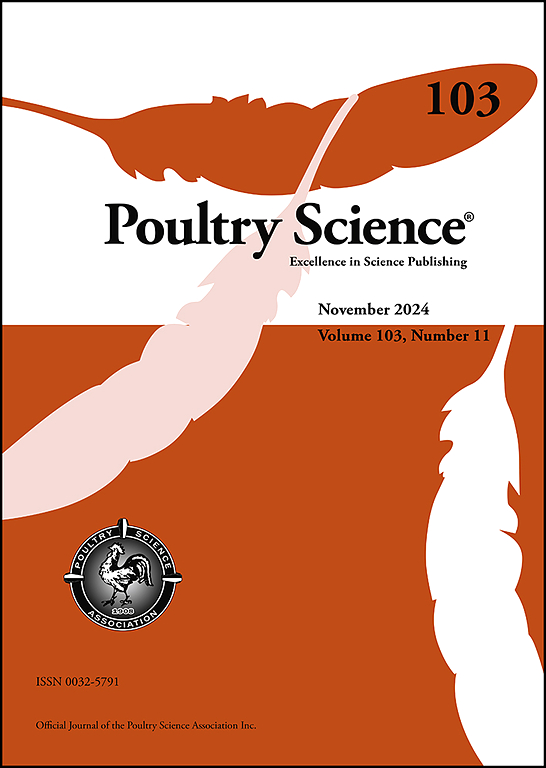The effects of dietary levels of corn distillers dried grains with solubles and supplementation of valine and isoleucine on growth performance, intestinal health, and cecal microbiome in Ross 708
IF 4.2
1区 农林科学
Q1 AGRICULTURE, DAIRY & ANIMAL SCIENCE
引用次数: 0
Abstract
The current study was conducted to investigate the effects of additional valine and isoleucine in a high corn distillers dried grains with solubles (DDGS) diet on growth performance, intestinal health, and cecal microbiome in broilers. A total of 800 0-d-old male Ross 708 were allocated into 5 dietary treatments with 8 replicates. The five diet groups were as follows: 1) corn-soybean meal (SBM)-based control (CON) group; 2) 15 % DDGS (15D) group (replacing corn and SBM with 15 % DDGS); 3) 15D + additional valine and isoleucine to have the same leucine:valine and leucine:isoleucine ratios as the CON group (15DB); 4) 30 % DDGS (30D) group; and 5) 30D + additional valine and isoleucine to have the same leucine:valine and leucine:isoleucine ratios as the CON group (30DB). The reduction in growth performance, carcass weight, breast muscle, and lean weight was intensified with increasing dietary DDGS levels. The 15DB group showed similar body weight gain (BWG) and carcass weight compared to the CON group. The 30DB group showed significant differences in phylum- and family-level cecal bacterial diversities compared to the 30D group but did not create significant growth improvement. No significant differences were observed in growth performance, carcass weight, body composition, intestinal morphology, jejunal gene expression levels, and alpha and beta diversity of cecal microbiota between the 15D and 15DB, and 30D and 30DB groups. Additional valine and isoleucine did not show consistent improvements in intestinal health and growth performance in DDGS-supplemented diets. The effect of additional valine and isoleucine varied depending on how much corn and SBM was replaced with DDGS in the diet, which may have been affected by additional factors other than intestinal health. In conclusion, additional valine and isoleucine may play a role in growth and muscle deposition but not have significant impact on the intestinal health in broiler diets that replaced corn and SBM with high levels of DDGS.
饲粮添加可溶玉米酒糟干颗粒及缬氨酸和异亮氨酸对罗斯708生长性能、肠道健康和盲肠微生物群的影响
本试验旨在研究在高含量玉米酒糟混溶物(DDGS)饲粮中添加缬氨酸和异亮氨酸对肉鸡生长性能、肠道健康和盲肠微生物群的影响。试验选用800只0 ~ d龄罗斯708雄性,随机分为5个饲粮处理,每组8个重复。5个饲粮组分别为:1)以玉米-豆粕(SBM)为基础的对照组(CON);2) 15% DDGS (15D)组(用15% DDGS代替玉米和SBM);3)添加15D +缬氨酸和异亮氨酸,使亮氨酸:缬氨酸和亮氨酸:异亮氨酸的比例与CON组相同(15DB);4) 30% DDGS (30D)组;5)添加30D +额外的缬氨酸和异亮氨酸,使亮氨酸:缬氨酸和亮氨酸:异亮氨酸的比例与CON组相同(30DB)。随着饲粮DDGS水平的增加,生长性能、胴体重、胸肌和瘦体重的下降加剧。15DB组的体增重和胴体重与CON组相近。与30D组相比,30DB组在门和科水平的盲肠细菌多样性方面存在显著差异,但没有显著的生长改善。15D组与15DB组、30D组与30DB组的生长性能、胴体重、体组成、肠道形态、空肠基因表达水平以及盲肠菌群α和β多样性均无显著差异。在添加了ddgs的日粮中,缬氨酸和异亮氨酸并没有显示出肠道健康和生长性能的持续改善。额外的缬氨酸和异亮氨酸的效果取决于饲粮中DDGS取代玉米和SBM的量,这可能受到肠道健康以外的其他因素的影响。由此可见,在以高水平DDGS替代玉米和SBM的饲粮中,添加缬氨酸和异亮氨酸可能对肉鸡生长和肌肉沉积有一定的促进作用,但对肠道健康没有显著影响。
本文章由计算机程序翻译,如有差异,请以英文原文为准。
求助全文
约1分钟内获得全文
求助全文
来源期刊

Poultry Science
农林科学-奶制品与动物科学
CiteScore
7.60
自引率
15.90%
发文量
0
审稿时长
94 days
期刊介绍:
First self-published in 1921, Poultry Science is an internationally renowned monthly journal, known as the authoritative source for a broad range of poultry information and high-caliber research. The journal plays a pivotal role in the dissemination of preeminent poultry-related knowledge across all disciplines. As of January 2020, Poultry Science will become an Open Access journal with no subscription charges, meaning authors who publish here can make their research immediately, permanently, and freely accessible worldwide while retaining copyright to their work. Papers submitted for publication after October 1, 2019 will be published as Open Access papers.
An international journal, Poultry Science publishes original papers, research notes, symposium papers, and reviews of basic science as applied to poultry. This authoritative source of poultry information is consistently ranked by ISI Impact Factor as one of the top 10 agriculture, dairy and animal science journals to deliver high-caliber research. Currently it is the highest-ranked (by Impact Factor and Eigenfactor) journal dedicated to publishing poultry research. Subject areas include breeding, genetics, education, production, management, environment, health, behavior, welfare, immunology, molecular biology, metabolism, nutrition, physiology, reproduction, processing, and products.
 求助内容:
求助内容: 应助结果提醒方式:
应助结果提醒方式:


